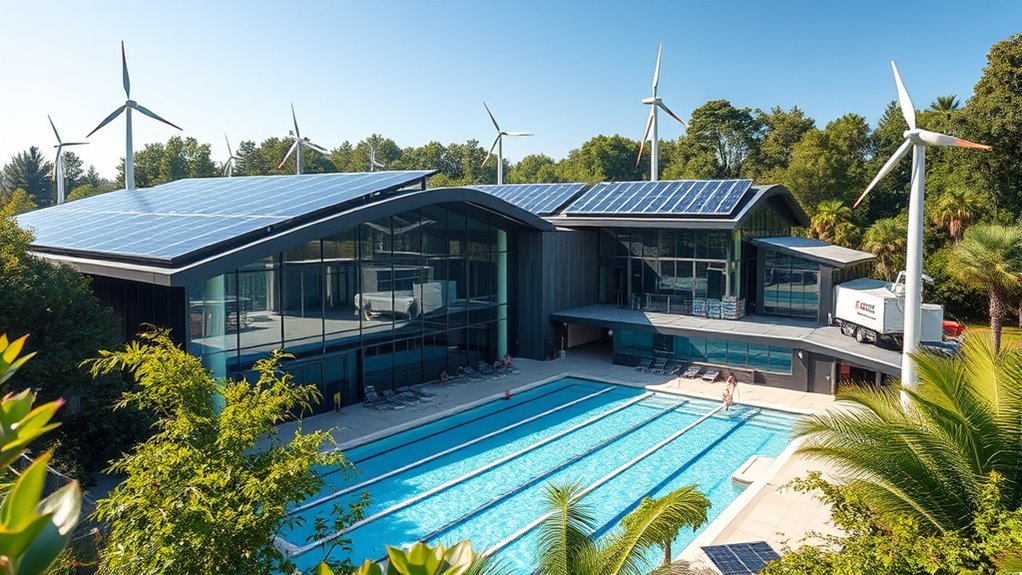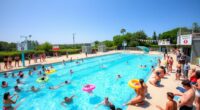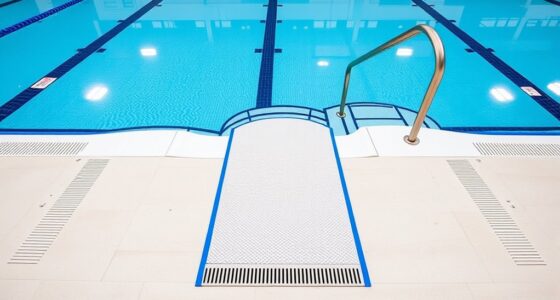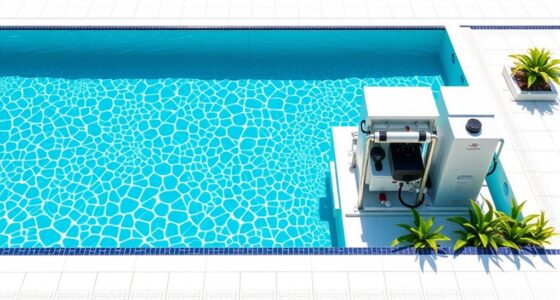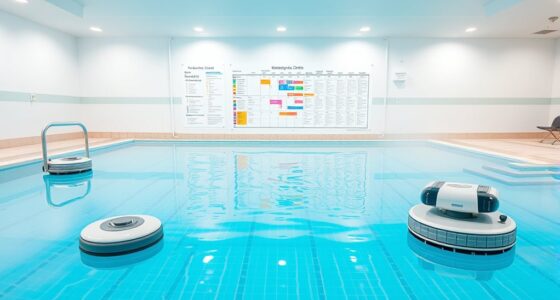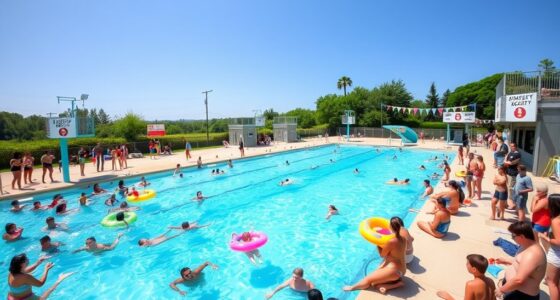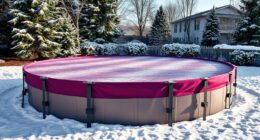To boost energy efficiency in your commercial aquatic center, focus on upgrading to high-performance insulation, installing energy-efficient lighting, and utilizing smart HVAC systems for better climate control. Implement water-saving fixtures like low-flow showers and urinals, and consider advanced filtration and recycling systems to reduce water use. Regular maintenance of pools and equipment also optimizes efficiency. Keep exploring to discover even more strategies that can profoundly cut costs and enhance sustainability in your facility.
Key Takeaways
- Implement high-performance insulation and energy-efficient lighting systems to reduce overall energy consumption.
- Utilize smart HVAC and water management systems for optimized climate control and water usage.
- Incorporate water-saving fixtures and advanced filtration to lower water heating and processing energy demands.
- Use renewable energy sources, like solar panels, to power facility operations and decrease reliance on grid energy.
- Regularly maintain pools and filtration systems to ensure energy-efficient performance and prevent wastage.
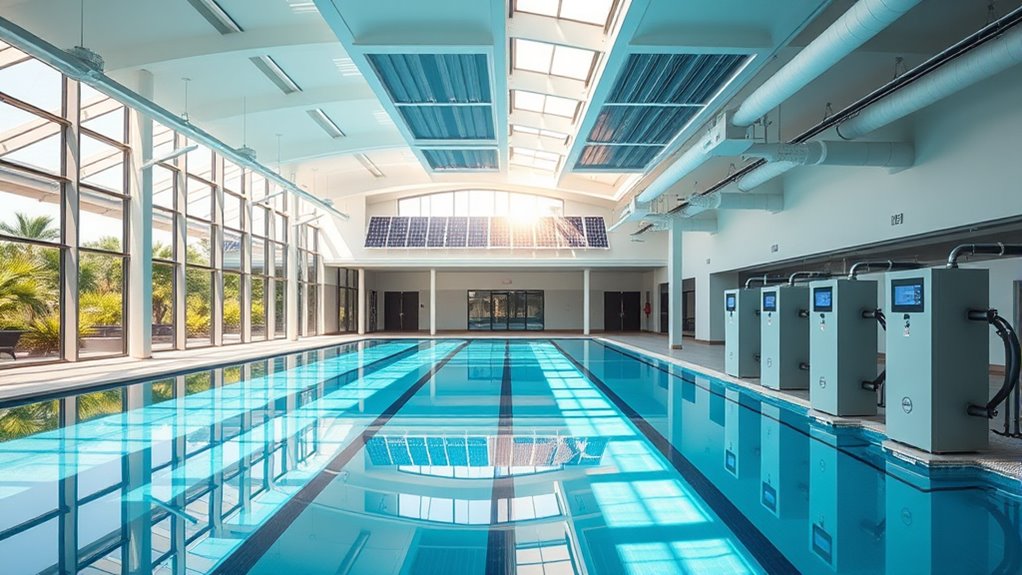
Energy efficiency is crucial for commercial aquatic centers looking to reduce operating costs and minimize environmental impact. One of the most effective ways to achieve this is by adopting green building practices. These practices focus on designing and operating facilities that optimize energy use, improve sustainability, and lower carbon footprints. When you incorporate green building principles, you’re not just making your aquatic center more eco-friendly—you’re also cutting long-term expenses. For example, installing high-performance insulation, energy-efficient lighting, and smart HVAC systems helps you manage energy consumption better. Additionally, using sustainable building materials reduces environmental harm and can lead to savings on maintenance and replacement costs over time. Incorporating antiques into your design can also create a warm, inviting atmosphere that enhances the overall environment and promotes comfort for visitors.
Water conservation is another critical aspect of improving energy efficiency in your aquatic center. Water heating and filtration demand a significant amount of energy, so reducing water use directly impacts your facility’s overall energy consumption. Implementing water-saving fixtures like low-flow showers, urinals, and faucets helps decrease water demand. You can also install advanced filtration systems that recycle water, minimizing wastage and reducing the need for constant fresh water input. When you prioritize water conservation, you’re not only lowering your water bills but also easing the load on your water heating systems, which consumes substantial energy. This dual benefit makes water conservation an indispensable component of your energy efficiency strategy.
To maximize water conservation, consider using smart controls that monitor water usage in real-time, enabling you to identify leaks or inefficiencies quickly. Regular maintenance of your pool and filtration systems ensures they operate at peak efficiency, preventing unnecessary energy drain. Additionally, covering pools when not in use can considerably reduce evaporation and heat loss, saving energy on heating and water replacement. Embracing these water conservation techniques aligns with your commitment to green building principles, reinforcing your facility’s sustainability goals.
Frequently Asked Questions
What Are the Initial Costs of Implementing Energy Efficiency Upgrades?
The upfront expenses for implementing energy efficiency upgrades vary based on the scope, but you can expect a significant capital investment initially. These costs cover equipment, installation, and planning. While the upfront expenses might seem high, they often lead to long-term savings through reduced energy bills. You’ll want to weigh these costs carefully against the benefits of improved efficiency, lower operating costs, and environmental impact.
How Do Energy Savings Compare to Investment Costs Over Time?
Think of your investment as planting a tree; the initial costs may seem high, but the long-term savings grow steadily. Over time, energy savings usually outweigh your upfront investment, especially when you conduct a thorough cost benefit analysis. This approach helps you see that the ongoing benefits—reduced utility bills and lower operational costs—make energy efficiency upgrades a smart, sustainable choice that pays off over the long haul.
Are There Government Incentives for Upgrading Aquatic Center Energy Systems?
Yes, you can benefit from government grants and tax incentives when upgrading your aquatic center’s energy systems. These programs aim to reduce upfront costs and encourage energy-efficient improvements. You should check with local and federal agencies for specific incentives available in your area. Applying for these grants and taking advantage of tax incentives can substantially lower your investment costs and accelerate your return on energy-saving upgrades.
How Can Staff Training Improve Energy Management?
You can improve energy management by focusing on staff training and engagement. When staff are actively involved and well-trained, training effectiveness increases, leading to better understanding of energy-saving practices. Engaged staff are more likely to identify inefficiencies and implement sustainable habits, reducing energy waste. Regular training sessions foster a culture of continuous improvement, ensuring everyone stays informed about new strategies and technologies that enhance overall energy efficiency in your aquatic center.
What Are the Most Common Challenges in Maintaining Energy-Efficient Systems?
Like chasing shadows, maintaining energy-efficient systems can seem elusive. You often face challenges like system reliability issues and equipment compatibility, which threaten to disrupt efficiency. When systems aren’t reliable, energy use spikes, and incompatible equipment can cause malfunctions or increased energy consumption. To overcome these hurdles, you need diligent maintenance, regular system assessments, and upgrading outdated equipment, ensuring your aquatic center runs smoothly and efficiently without interruption.
Conclusion
Think of your aquatic center as a well-tuned orchestra, where each energy-saving strategy is a crucial instrument. When all parts work in harmony, your facility runs smoothly, efficiently, and sustainably. By implementing these strategies, you’re conducting a masterpiece that conserves resources and reduces costs. Remember, just like a symphony, continuous tuning and attention ensure your aquatic center performs at its best—bright, vibrant, and eco-friendly for years to come.
